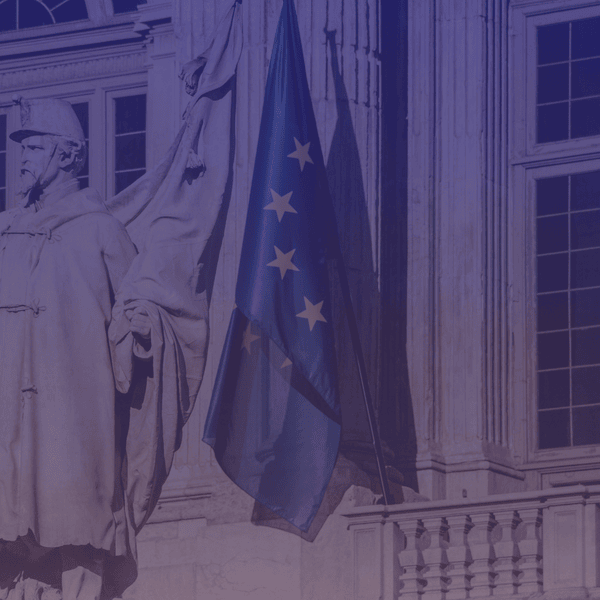
Author: Anouk Laurian
Edited by: Alessia Calarese
Recent Eurobarometer surveys indicate that most EU citizens report feeling European (European Commission, 2023). Although the majority of participants said that they still primarily identify with their national identity (European Commission, 2015), the emergence of a European identity is a remarkable achievement; one that is not incidental but rather the result of deliberate and sustained efforts by the European Union. This article explores the EU’s use of educational policy as a tool for fostering a sense of “Europeanness” among its citizens. It argues that identity formation at the European level is actively promoted through educational initiatives such as Erasmus+ and the European Education Area, which aim to diffuse shared values and encourage mobility and cross-cultural exchange. These programs demonstrate how education serves both as a channel for integration and as a means of strengthening civic trust in the EU. Amid rising euroscepticism and geopolitical instability, fostering a shared European identity and strengthening cross-cultural bonds are crucial for the democratic legitimacy and long-term global relevance of the EU. By emphasizing shared values while honoring national diversity, the EU aspires to build a pluralistic identity that can support its long-term unity.
Defining Identity in the European Context
According to Fukuyama (2018), identity refers to a sense of belonging to a specific cultural, geographical or even political group. National identity, in particular, is often grounded in shared territory, culture, history, and language (Liu & Turner, 2018). These elements are usually clearly defined within most European countries, and are further reinforced through education and socialization. In contrast, European identity is more abstract. While nations can be distinguished from one another by their borders and populations, Europe’s boundaries are not as clearly defined (Chopin, 2018). The EU territory is not the same as that of the continent of Europe. Nor are its population and territory static, as the EU can both be enlarged and recede, as shown by events like Brexit. Additionally, Europe’s history is marked not only by cooperation and collaboration, but also by fierce competition and territorial disputes (Chopin, 2018). While some may interpret this shared and entangled history as the basis for feeling European, instead of just a national of one’s own country, others may emphasize these historic conflicts and maintain a sense of distrust in other countries, reinforcing a sense of loyalty to their own nation. It should come as no surprise that most citizens in EU countries feel a much stronger attachment to their nation, than to the EU.
The Emergence of “European” identity
The concept of a national identity often remains more immediate and emotionally resonant than that of “European” identity. Nonetheless, 87% of citizens in EU countries identify as citizens of the EU, not only as citizens of their own country (European Commission, 2023).
One of the reasons for this is the role of the EU as an institution: having made it its goal to forge cooperation, interconnection, and promote shared values (Article 3 TEU), the EU has taken significant steps towards institutional integration. The removal of internal borders has increased mobility, while economic and diplomatic coordination and cooperation may have further eliminated internal barriers and perceptions of “us vs. the others” within the EU (Salomon & Rijpma, 2023). Most importantly, the EU defines itself as a community of values, based on the respect of human dignity, freedom, democracy, equality, the rule of law and the respect of Human Rights. Member States must commit to these values, which are meant to serve as a point of convergence between national and European identity (Chopin, 2018).
By creating opportunities for interaction and collaboration across member states and individuals, the EU promotes a perception of unity amongst member states, for instance, within common markets or regarding their fundamental values. This perception of unity can help explain why many EU citizens self-identify as European, and is especially important in times of rising nationalism and polarization (Verhaegen, 2018).
Why does the EU care about whether citizens feel “European”?
As Fukuyama (2018, p. 8) explains, the “shared belief in the legitimacy of the country’s political system” lies at the core of (national) identity. When individuals see themselves as part of a broader community, such as the European community, and trust its legitimacy, they are more likely to support and contribute to it. The EU’s democratic legitimacy depends on citizen participation (De Jongh & Theuns, 2017). A strong European identity can enhance civic engagement at the EU level, strengthen public trust in EU institutions, and support collective action on global challenges, such as the war in Ukraine (Damiani et al., 2024). Moreover, the perception of a shared European identity reinforces citizens’ commitment to the EU’s foundational values and thus to the EU itself (Fligstein et al., 2012). This is especially important in today’s context of rising Euroscepticism and geopolitical instability. Therefore, fostering a European identity based on common values and a will to protect and diffuse these globally is not merely symbolic for the EU, but also strategic.
EU Educational projects promoting European Identity
Because of the importance of creating a sense of “European” identity, the EU has undertaken several educational measures to push this project on.
- Erasmus+
Launched by the European Commission in 1987, Erasmus+ is one of the EU’s most well-known initiatives, designed to support education, training, youth and sport in Europe. It’s best known for its mobility opportunities, giving young individuals the opportunity to go abroad and discover different cultures, building meaningful connections with people from other countries (European Commission, 2021).
As of 2024, over 15 million individuals from EU member states have taken part in Erasmus+ , engaging in the kind of cross-border experiences that, as the Commission highlights, fosters social cohesion and a stronger sense of European identity (European Commission, 2021; European Commission 2024).
Indeed, research supports this claim. Mitchell (2015) found that students who initially did not identify as European were significantly more likely to do so after participating in Erasmus+. She notes that this so-called “Erasmus effect” is stronger when individuals are in contact with other Europeans during the program, rather than only with co-nationals. However, she also points out that most participants are already predisposed to feeling European, meaning the program’s positive impact on fostering a collective European identity is limited to the small group of Erasmus+ participants that originally did not identify as European.
In 2023, only 1.3 million individuals had the opportunity of participating in the program. Though these are large numbers, this is only a miniscule fraction of the 448 million people living in the EU territory. Erasmus+ requires significant funding – 4.5 billion euros in 2023 (European Commission, 2024) – and as such it cannot possibly accommodate every young person in the EU. This is a significant limitation of the Erasmus+ program, which disproportionately affects socioeconomically disadvantaged youth (Davies, 2020), who already have fewer mobility opportunities and are therefore less likely to feel European, maintaining stronger national identities instead (Fligstein et al., 2012).
Consequently, the program’s structural barriers tend to exclude those least connected to a European identity, reducing its overall potential to foster a shared sense of belonging. There is, however, potential for improvement: in 2021, the European Commission adopted a framework aiming to make Erasmus+ more inclusive by expanding participation opportunities for disadvantaged youth (European Commission, 2021).
- The European Education Arena
The European Education Area (EEA), envisioned by the European Commission in 2020 and supported by the Council of the European Union in 2021, aims to create a more equitable, integrated, sustainable and coordinated educational space across EU member states. The EEA promotes goals such as quality education, inclusion, gender equality and the digital and green transitions. By supporting member states to collaborate with important stakeholders, such as student organisations, educational providers, and national policy-makers, they encourage policy coordination across member states, focused on improving quality and equity in education in order to “promote a stronger Europe in the world” (European Commission, 2020, para. 3). This increased harmonization of education policies further facilitates student mobility and encourages the promotion of EU values through school curricula.
The former Vice-President for promoting the European Way of Life, Margaritis Schinas, acknowledged the important role of education in maintaining the European way of life, reaffirming that the EEA is rooted in the European values of freedom, diversity, human rights and social justice (European Parliamentary Research Service, 2021). Similarly, Ursula von der Leyen emphasized education’s role in shaping the future of European society and economy (European Commission, 2020).
The EEA is to be achieved by 2025. Progress reports from 2022 indicated that significant progress has been made in areas such as the promotion of equity and inclusion, the development of education materials and curriculum development. However, it draws attention to the fact that some areas, such as giving teachers and students a voice in the development of the EEA and bettering the dissemination of information between the Working Groups tasked with implementing EEA actions, require further improvement efforts (European Commission, 2023). A full report evaluating whether the EEA has been achieved in the way it was intended by 2025 is expected later this year.
Conclusion
Fostering and disseminating a shared European identity among EU citizens is vital to the Union’s long-term success and democratic legitimacy. To this end, the EU has launched several initiatives aimed at reinforcing this identity, for instance, through educational initiatives such as Erasmus+ and the European Education Arena. So far, these initiatives appear to be having a positive impact on participants.
The report on the success of the EEA, expected later this year, will be pivotal in assessing its contribution to the creation of a European identity. Should the program have proven to be successful, and provided member states continue to uphold its principles, it is to be expected (or at least hoped) that a whole new generation of citizens attending school in the EU will emerge with a much deeper understanding of the EU and a more meaningful connection to it. Ideally, this will sustain and strengthen the EU project in the years to come. In times of growing Euroscepticism, the success of the EEA could prove to be an enormous chance for the EU to reaffirm its importance and legitimacy.
When considering what constitutes a European identity, it is important to recognize that it need not exist in opposition to national identity (Debattista, 2023). The two are not mutually exclusive. One of the EU’s most remarkable features, and indeed one that makes it a political and civic system that is unlike any other, is its ability to unite individuals from diverse cultural backgrounds. It allows citizens not only to coexist peacefully but also to actively collaborate and work toward shared goals and values. At the same time, it enables them to remain rooted in their own cultural traditions and national ideas and values. In fact, one of the Union’s greatest strengths lies in its cultural pluralism, a value enshrined in its foundational principles, which emphasize the protection of diversity and promotion of tolerance (Article 2 TEU). These considerations should be at the heart of any vision for a truly inclusive and sustainable European identity. Amid increasing polarization, educational initiatives have great potential to shape European identities built on shared values, thereby fostering cooperation for a more peaceful and unified Europe.
Sources
Chopin, T. (2018, 19 March). Europe and the identity challenge: Who are “we”?. Fondation Robert Schuman. https://www.robert-schuman.eu/en/european-issues/0466-europe-and-the-identity-challenge-who-are-we
Damiani, V., Losito, B., Agrusti, G. & Schulz, W. (2024). Young citizens’ views and engagement in a changing Europe. IEA international civic and citizenship education study 2022 European report. European Commission. https://www.iea.nl/publications/study-reports/national-reports-iea-studies/iccs-2022-european-report
Davies, H. (2020, February 20). Erasmus+ and the disadvantaged student: fault lines and hope. EUA – European University Association. https://www.eua.eu/our-work/expert-voices/erasmus-and-the-disadvantaged-student-fault-lines-and-hope.html
Debattista, A. P. (2023). The EU and the Multifaceted Nature of European Identity. European View, 22(1), 146–146. https://doi.org/10.1177/17816858231166258
De Jongh, M., Theuns, T. (2017). Democratic legitimacy, desirability, and deficit in EU governance, Journal of Contemporary European Research, 13(3): 1283-1300. https://sciencespo.hal.science/hal-03458921/file/2017-de-jongh-democratic-legitimacy-desirability-and-deficit-in-eu-governance.pdf
European Commission. (2020, 30 September). Achieving a European Education Area by 2025 and resetting education and training for the digital age. https://ec.europa.eu/commission/presscorner/detail/en/ip_20_1743
European Commission. (2021). Erasmus+ 2021-2027. Enriching lives, opening minds through the EU programme for education, training, youth and sport. Publications Office of the European Union. https://op.europa.eu/en/publication-detail/-/publication/ff1edfdf-8bca-11eb-b85c-01aa75ed71a1/language-en
European Commission. (2021). The Commission makes Erasmus+ and the European Solidarity Corps more inclusive. European Commission. https://ec.europa.eu/commission/presscorner/detail/en/ip_21_5402
European Commission. (2023). European Education Area midterm review process report. https://education.ec.europa.eu/sites/default/files/2023-11/European%20Education%20Area%20midterm%20review%20process%20report%20231123.pdf
European Commission. (2023). Flash Eurobarometer 528. Citizenship and democracy. Ipsos European Public Affairs. https://europa.eu/eurobarometer/surveys/detail/2971
European Commission. (2024). Erasmus+ annual report 2023. Publications Office of the European Union. https://op.europa.eu/en/publication-detail/-/publication/884d8a20-ac87-11ef-acb1-01aa75ed71a1/language-en#
European Parliamentary Research Service. (2021). Implementation of citizenship education actions in the EU. European implementation assessment. European Parliament. https://www.europarl.europa.eu/RegData/etudes/STUD/2021/694207/EPRS_STU(2021)694207_EN.pdf
Fligstein, N., Polyakova, A., & Sandholtz, W. (2012). European integration, nationalism and European identity. Journal of Common Market Studies, 50(s1), 106–122. https://doi.org/10.1111/j.1468-5965.2011.02230.x
Fukuyama, F. (2018). Why national identity matters. Journal of Democracy, 29(4), 5–15. https://doi.org/10.1353/jod.2018.0058
Liu, Q., & Turner, D. (2018). Identity and national identity. Educational Philosophy and Theory /, 50(12), 1080–1088. https://doi.org/10.1080/00131857.2018.1434076
Mitchell, K. (2015). Rethinking the “Erasmus Effect” on European identity. Journal of Common Market Studies, 53(2), 330–348. https://doi.org/10.1111/jcms.12152
Salomon, S., & Rijpma, J. (2023). A Europe Without internal frontiers: Challenging the reintroduction of border controls in the Schengen Area in the light of Union citizenship. German Law Journal, 24(2), 281–309. https://doi.org/10.1017/glj.2021.60
Verhaegen, S. (2018). What to expect from European identity? Explaining support for solidarity in times of crisis. Comparative European Politics, 16(5), 871–904. https://doi.org/10.1057/s41295-017-0106-x

 The ’Ndrangheta’s Infiltration and Threat to European Institutions
The ’Ndrangheta’s Infiltration and Threat to European Institutions  From Paper to Practice: How Grassroots Norms Undermine Gender Rights in Pakistan
From Paper to Practice: How Grassroots Norms Undermine Gender Rights in Pakistan  Exploited Childhoods: The Role of Global Corporations in Perpetuating and Mitigating Child Labour
Exploited Childhoods: The Role of Global Corporations in Perpetuating and Mitigating Child Labour  Human Rights Challenges in Addressing SLAPPs in Media, NGOs and Journalism in the EU
Human Rights Challenges in Addressing SLAPPs in Media, NGOs and Journalism in the EU 


